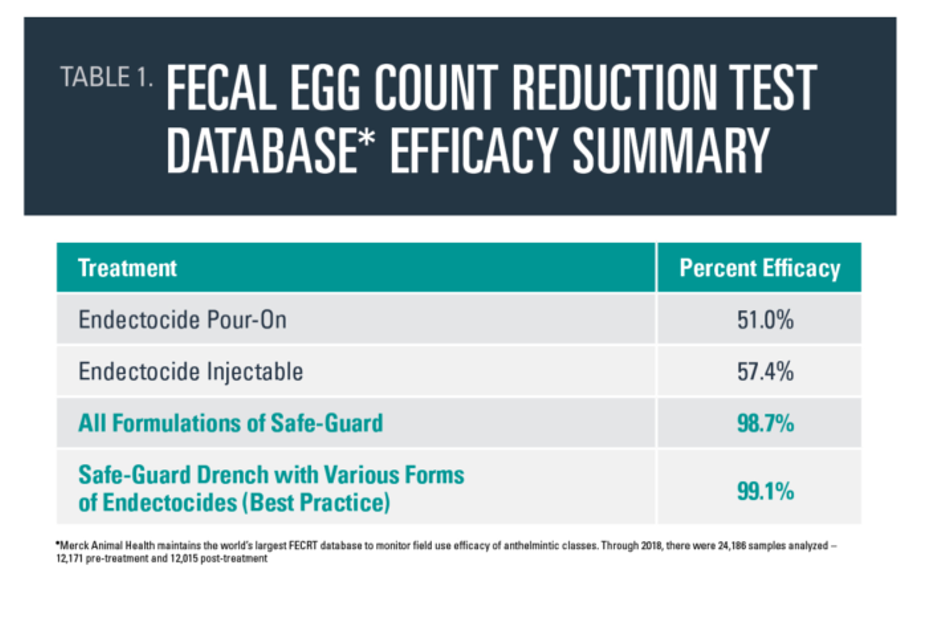Deworming to maximize cattle performance
By Harold Newcomb, DVM, Technical Services Manager, Merck Animal Health
Parasite control should be the cornerstone of an animal health program because parasites negatively
impact the overall health and performance of cattle. If producers are only using an endectocide, such as ivermectin, they may only be getting half of the reduction in worms necessary to maintain feed intake, average daily gain, milk production, as well as create a positive immune response to vaccines and diseases.
For more than a decade, Merck Animal Health has maintained the world’s largest Fecal Egg Count
Reduction Test (FECRT) database to monitor field-use efficacy of dewormers approved for use in cattle in the U.S. From 2009-18, results from 721 trials and more than 24,000 samples, representing more than
24 states, have been compiled.
The bottom line is the endectocide pour-on and injectable products performed well below the 90
percent fecal egg count reduction threshold that is critical to ensuring proper parasite management.
With an endectocide pour-on product, a mere 51 percent efficacy was attained. Nearly half of the eggs
remained 14 days after receiving the pour-on.
Adding Safe-Guard® (fenbendazole) made a tremendous difference. When Safe-Guard was given,
99.1 percent effectiveness was obtained.

For maximum efficacy, take these four steps:
1) If producers are using a dewormer that ends in “-ectin”, consider adding another product where the active ingredient ends in “-zole”, such as Safe-Guard or Panacur®, which contain the active ingredient fenbendazole. Not only does a concurrent deworming program most effectively control internal parasites, it also ensures a sustainable deworming program that helps keep resistance to a minimum.
2) Deworm cattle at the right time. Treat cattle at turnout. Deworming cattle that are on pasture does not require gathering and processing cattle and can be highly effective. Using feed and mineral forms of Safe-Guard – such as range cubes, dewormer blocks or mineral – requires relatively little time and labor.
3) Properly estimate animal weights so a full dose of dewormer is used. If producers dose based on the average weight of the group, they are actually under-dosing some of animals, which can contribute to reduced efficacy.
4) Producers should work with their veterinarian to do FECRT testing annually. It is important that 20 samples are taken both at treatment and 14 days post-treatment. If there is less than a 90-percent reduction in fecal egg count, a Polymerase Chain Reaction (PCR) test – which is a DNA-based test – should be conducted to determine which parasites remain.
Learn more at SafeGuardWorks.com.
IMPORTANT SAFETY INFORMATION | RESIDUE WARNINGS
CATTLE: Do not use in beef calves less than 2 months old, dairy calves and veal calves. A withdrawal period has not been established for this product in pre-ruminating calves. Additionally, the following meat withdrawal and milk discard times apply:
Safe-Guard Paste: Cattle must not be slaughtered for 8 days. For dairy cattle, the milk discard time is 96 hours.
Safe-Guard Suspension: Cattle must not be slaughtered for 8 days. For dairy cattle, the milk discard time is 48 hours.
Safe-Guard ENPROAL Type C Medicated Block: Cattle must not be slaughtered for 11 days. For use in beef cattle only.
Safe-Guard 20% Protein Type C Medicated Block: Cattle must not be slaughtered for 16 days. For use in beef cattle only.
Safe-Guard Type A and other medicated feed products (pellets, cubes, free-choice mineral, or free-choice liquid): Cattle must not be slaughtered for 13 days. For dairy cattle, the milk discard time is 60 hours.
Read other articles here:
